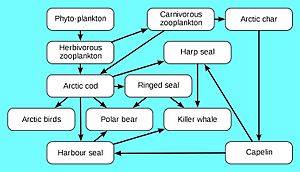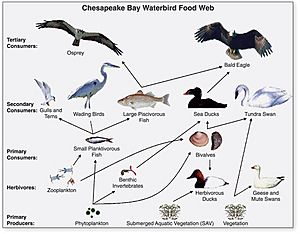Food chain facts for kids
A food chain shows the feeding relationship between different organisms in a particular environment and/or habitat. Plants are at the bottom of a food chain because they are producers that make their food from a process called photosynthesis . Organisms that can make their own food are called producers. Consumers are animals that eat the products of producers or other animals. The animal that eats the producer is called the primary consumer and it gains the most amount of energy. The animal that eats the primary consumer is called a secondary consumer which in the primary consumer's energy which is transferred becomes lower due to the primary consumer consuming some energy. The animal that eats the secondary consumer is called a tertiary consumer and so on to fourth, fifth, etc. For example, a food chain might start with a green plant as the producer, which is eaten by a snail, the primary consumer. The snail might then be the prey of a secondary consumer such as a frog, which itself may be eaten by a tertiary consumer such as a snake which in turn may be consumed by an eagle. The direction of arrows between the organisms shows who eats what and what gets eaten by what.
A food chain also represents a series of events and consumption in which food and energy are consumed from one organism in an ecosystem to another. Food chains show how energy is passed from the sun to producers, from producers to consumers, and from consumers to decomposes such as fungi. They also show how animals depend on other organisms for food.
In any ecosystem, many food chains overlap. Different food chains may include some of the same organisms. Several consumers may eat the same kind of plant or animal for food. When this happens, the food chain forms a food web. A food web shows how food chains are related within an ecosystem and how the cycles balanced between an equilibrium
Food chains are very important for the survival of most species. When only one element is removed from the food chain it can result in extinction of a species in some cases. The foundation of the food chain consists of primary producers. Primary producers, or autotrophs, utilize energy derived from either sunlight or inorganic chemical compounds to create complex organic compounds, whereas species at higher trophic levels cannot and so must consume producers or other life that itself consumes producers. Because the sun's light is necessary for photosynthesis, most life could not exist if the sun disappeared. Even so, it has recently been discovered that there are some forms of life, chemotrophs, that appear to gain all their metabolic energy from chemosynthesis driven by hydrothermal vents, thus showing that some life may not require solar energy to thrive.
Decomposers, which feed on dead animals, break down the organic compounds into simple nutrients that are returned to the soil. These are the simple nutrients that plants require to create organic compounds. It is estimated that there are more than 100,000 different decomposers in existence.
Many food webs have a keystone species. A keystone species is a species that has a large impact on the surrounding environment and can directly affect the food chain. If this keystone species dies off it can set the entire food chain off balance. Keystone species keep herbivores from depleting all of the foliage in their environment and preventing mass extinction.
Food chains were first introduced by the Arab scientist and philosopher Al-Jahiz in the 10th century and later popularized in a book published in 1927 by Charles Elton, which also introduced the food web concept.
Length
The length of a food chain is a continuous variable providing a measure of the passage of energy and an index of ecological structure that increases through the linkages from the lowest to the highest trophic (feeding) levels.
Food chains are often used in ecological modeling (such as a three-species food chain). They are simplified abstractions of real food webs, but complex in their dynamics and mathematical implications.
Ecologists have formulated and tested hypotheses regarding the nature of ecological patterns associated with food chain length, such as increasing length increasing with ecosystem size, reduction of energy at each successive level, or the proposition that long food chain lengths are unstable. Food chain studies have an important role in ecotoxicology studies, which trace the pathways and biomagnification of environmental contaminants.
Food chains are directional paths of trophic energy or, equivalently, sequences of links that start with basal species, such as producers or fine organic matter, and end with consumer organisms.
Producers, such as plants, are organisms that utilize solar or chemical energy to synthesize starch. All food chains must start with a producer. In the deep sea, food chains centered on hydrothermal vents and cold seeps exist in the absence of sunlight. Chemosynthetic bacteria and archaea use hydrogen sulfide and methane from hydrothermal vents and cold seeps as an energy source (just as plants use sunlight) to produce carbohydrates; they form the base of the food chain. Consumers are organisms that eat other organisms. All organisms in a food chain, except the first organism, are consumers.
Food chain length is important because the amount of energy transferred decreases as trophic level increases; generally only ten percent of the total energy at one trophic level is passed to the next, as the remainder is used in the metabolic process. There are usually no more than five tropic levels in a food chain. Humans are able to receive more energy by going back a level in the chain and consuming the food before, for example getting more energy per pound from consuming a salad than an animal which ate lettuce.
The efficiency of a food chain depends on the energy first consumed by the primary producers. The primary consumer gets its energy from the producer and passes it to the secondary and tertiary consumers.
Images for kids
-
Food chain in a Swedish lake. Osprey feed on northern pike, which in turn feed on perch which eat bleak which eat crustaceans
See also
 In Spanish: Cadena trófica para niños
In Spanish: Cadena trófica para niños



